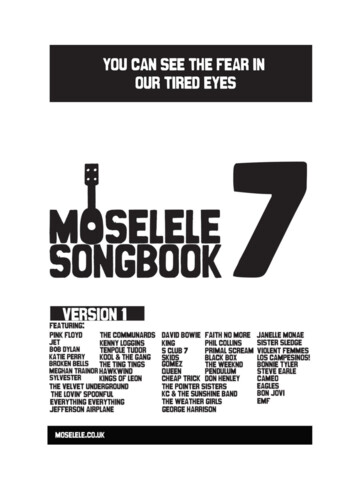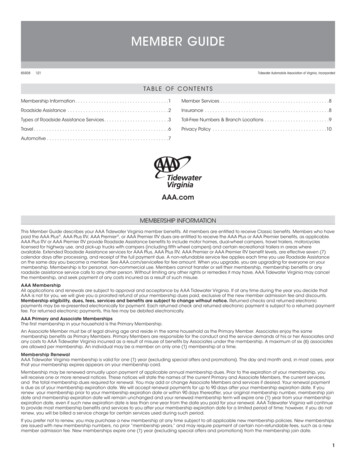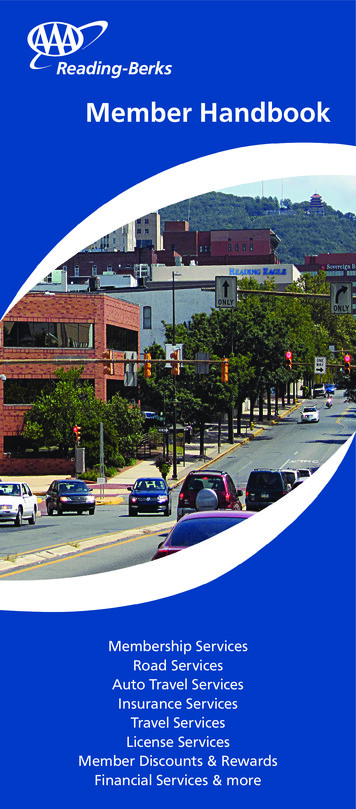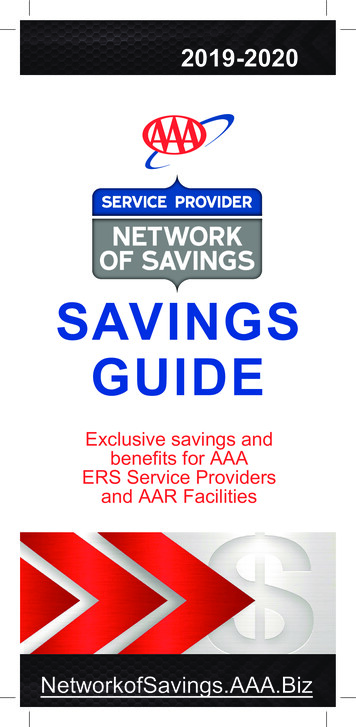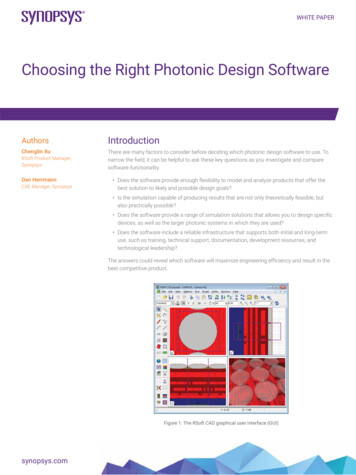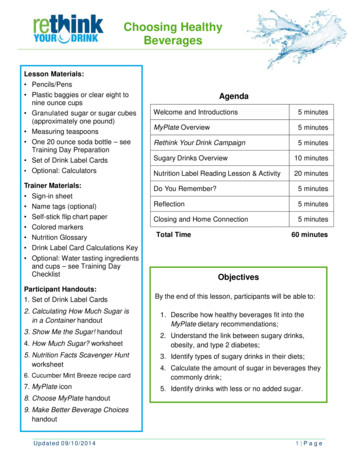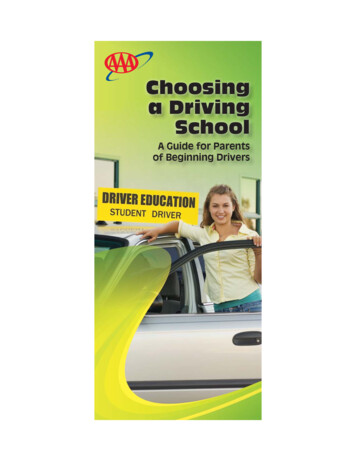
Transcription
Choosinga DrivingSchoolA Guide for Parentsof Beginning Drivers
RIVERå%DUCATION åA Foundation for Safe DrivingGetting a driver’s license is animportant step to adulthoodfor young, new drivers.Classroom training provides asolid base for grooming safedrivers, but getting behind the wheel on theopen road is the true test.Learning to drive and successfully navigateAmerica’s roadways is like building a house. Youneed knowledge, skills, and plans. Without thesesolid foundations, you take a big risk each timeyou get behind the wheel.Quality driving instruction provides thefoundation needed for safe driving practices.Instructors ensure their students have the basicskills, knowledge, and habits needed for safetyon the road. Structured classroom and behindthe-wheel instruction are the first steps inpreparing students for the rigors of today’shighway system.Why Use a ProfessionalDriving School?Even parents who have the time andtemperament to teach their teens to driveshould consider the added benefits of trainingby an expert. Driver training is important. Youmay be an exceptional driver but not the bestteacher — either because your competence is soingrained it has become unconscious, or becauseyou are more likely to overreact to your ownchildren.Professional instructors have been trained toprovide comprehensive training that addressesthe mistakes new drivers are most likely to make.Even parents who are exceptional drivers should
consider professional training by an expert.Check with your local AAA club for references.Any school that displays the AAA logo has beenthoroughly reviewed and must maintain:ååsåLATE MODEL åSAFEåDRIVERåTRAININGåCARS ååsåUP TO DATEåTRAININGåMATERIALS ååsåPROFESSIONALLYåTRAINEDåINSTRUCTORS ååsåAåRECORDåOFåGOODåBUSINESSåPRACTICES ååsåDISCOUNTSåTOå!!!åMEMBERS 1UALITY åTHEå.UMBERå/NEå0RIORITYToo many parents seek driving schools thatare low-cost, short in duration, or simplyconvenient to get to. While these factors areimportant, one other factor should outweighthem all – quality. Given that motor vehiclecollisions are the leading cause of death forteenagers, it’s absolutely worth the effort toidentify a top-notch driving school wherequality is the number one priority.If you are looking for a quality driving school, thisbrochure will help you:ååsåå YOURåNEEDS HEåFACILITY åINSTRUCTOR åSTRUCTUREåANDåLESSONS RIVINGåschools.
Make a Smarter,-OREå)NFORMEDå#HOICEYour search for a quality school may be moresuccessful if you know what to look for infacilities, instructors, structure, and lesson plans.The following tips may make it easier to selectthe best driver training school for you. Look forschools that:T Belong to a professional national or stateassociation for Driver Education and Safety.Organizations that help driving schools and theirinstructors stay current on modern learningtechniques and evolving driving skills include:The American Driver and Traffic SafetyEducation Association (ADTSEA.org)The Driving School Association of theAmericas (TheDSAA.org)Your state may also have its own professionalassociation for driving schools. You can havemore confidence that driving schools belongingto these organizations have a strongcommitment to quality and truly preparing yourteen for the challenges of modern driving.T Have professional-looking facilities andvehicles. Ask to see the classrooms and if youcan observe part of a course. Classrooms shouldbe clean, orderly, and set up to conductclassroom sessions. Also ask to see thetraining vehicles, which should be late-modelcars in good condition.T Offer at least 30 hours of classroom instructionand six to ten hours of behind-the-wheeltraining. This should not necessarily beinterpreted as sufficient time for instructionyour teen may need more time behind-thewheel before he or she is ready to drive. Avoid“quickie” courses- optimally, the course shouldbe taught for at least a 4 to 6 week duration.T Integrate the classroom and behind-thewheel portions of instruction. The ideal course
integrates the classroom and behind-the-wheeltraining. The classroom time should consist of aprofessionally-developed, structured lesson planthat includes coverage of risk prevention and thefundamentals of defensive driving. Behind-thewheel sessions should correspond with the classroom lesson plan to reinforce and demonstratethe practical usage of the classroom concepts.Driving environments should include residentialstreets, city traffic, rural roads, highways, andlimited-access freeways.T Have a good business reputation. Check withthe Better Business Bureau (BBB.org),which keeps files of complaints andcompliments received about local businesses.Also check that the school’s Driver EducationSchool license is displayed in the school’sbusiness office.T Will gladly give you references. Get the namesof previous students and parents you may callas a reference. Ask them about their experiencewith the school.T Are clear about details. Ask about refundpolicies, class make-up policies, and remedialtraining policies. Do you need to sign a contract?T Can accommodate students withdisabilities. Students with disabilities shouldchoose a school with instructors and equipmentprepared for their specific needs. For instance,vehicles should include hand controls, anadjustable steering column, and other aids fordisabled drivers. The Association of DriverRehabilitation Specialists (ADED.net) can provideinformation about facilities in your area.
T Offer a “Parent OrientationSession.” Most parents aresurprised to learn how valuablesuch a session is. Generallyless than two hours in length,these sessions help parentsunderstand how the schoolworks, the parent’s role inthe learning-to-drive process,and what tools are available toparents and families, such asa Parent-Teen Driving Agreement*. Do not missthe opportunity to attend a parent orientationsession- they’re invaluable!T Offers tools to help parents be effectivedriving coaches. Classroom and behind-thewheel lessons should be supported by practicesessions, and many schools provide materials andregular input from instructors regarding aparticular student’s needs. Parents shouldprovide at least 50 hours of supervised practicedriving experience for novice drivers.*Download a Parent-Teen Driving Agreement atTeenDriving.AAA.comYour Role:The Driving CoachTo support you as your teen’sdriving coach, AAA developed“Teaching Your Teens toDrive.” This program wasdesigned to help parentsparticipate in the process ofeducating teenagers, includinghow to conduct practicesessions with your young driver behind thewheel. “Teaching Your Teens to Drive” helpsyou prepare your teen driver for this new phasein their life, with 13 lessons focused ondeveloping the following skills:ååså"ASICåVEHICLEåCONTROL ååså6ISUALåSEARCHåHABITS
T ååså0ASSINGåANDåOFF ROADåMANEUVERS ååså&REEWAYåANDåNIGHTåDRIVING ååså RIVINGåONåSLIPPERYåSURFACES åANDååså2EDUCINGåRISKS To order “Teaching Your Teens to Drive,” callAAA at 800-327-3444, contact your local AAA/CAAclub, or visit TeenDriving.AAA.comMakingYour DecisionBefore you select a driving school, ask aroundcheck with friends and neighbors. Be sure tovisit several schools, and investigate eachthoroughly. New teen drivers are at high riskbehind the wheel, and your diligence in locatinga quality school that meets your needs will payoff – it’s worth the effort.ResourcesAAA Driving Schools in Your Area– AAA.comAssociation of Driver Rehabilitation Specialists–ADED.netThe American Driver and Traffic Safety EducationAssociation– ADTSEA.orgThe Driving School Association of the Americas–TheDSAA.orgBetter Business Bureau– BBB.orgTeenDriving.AAA.com
AAA’s “Teaching Your Teens to Drive”is there to help with a colorfully illustratedhandbook and live-action 60-minute DVD.For more information, contact your localAAA club or call 800-327-3444.Provided as a public service by your AAA club.For more information aboutAAA Driver Training Programs,contact your local AAA club’sDriver Training Departmentor visit AAA.biz/DriverTrainingDriver Training Programs1000 AAA DriveHeathrow, Florida32746-5063!!! #OMåså */). !!!Copyright 2011 AAA. All rights reserved. Printed in the U.S.A. August 2011Stock Number 3383
Why Use a Professional Driving School? drivers, but getting behind the wheel on the open road is the true test. Learning to drive and successfully navigate America’s roadways is like building a house. You need knowledge, skills, and plans. Without these solid foundations, you take a big risk each time you get behind the wheel. Quality driving instruction provides the foundation needed for .

